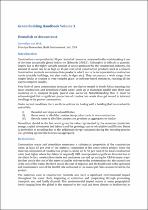JavaScript is disabled for your browser. Some features of this site may not work without it.
- ResearchSpace
- →
- Research Publications/Outputs
- →
- Book Chapters
- →
- View Item
| dc.contributor.author |
Van Wyk, Llewellyn V

|
|
| dc.date.accessioned | 2011-03-16T07:31:37Z | |
| dc.date.available | 2011-03-16T07:31:37Z | |
| dc.date.issued | 2010-11 | |
| dc.identifier.citation | van Wyk, L. 2010. Green building handbook volume 3: Demolish or deconstruct. Alive2green, November 2010 | en_US |
| dc.identifier.isbn | 9780620452403 | |
| dc.identifier.uri | http://hdl.handle.net/10204/4904 | |
| dc.description | Copyright: 2010 Alive2green | en_US |
| dc.description.abstract | Construction is responsible for 50 per cent of all resources consumed in the world making it one of the least sustainable global industries. Although it is difficult to quantify, largely due to the highly variable amount of waste generated by the construction industry, the amount of waste can be as high as 15 per cent of all construction products used in a project. Construction products are intermediate products, which are to be incorporated in construction works (notably buildings, but also roads, bridges etc.). They encompass a wide range, from simple bricks or cement to very complex glass- or polymer-based structures, reaching all the way to complete facades. Very little of these construction products are recycled or reused in South Africa meaning that most construction and demolition (C&D) waste lands up in municipal landfill sites (best case scenario) or is dumped illegally (worst case scenario). Notwithstanding this, it must be acknowledged that a significant proportion of construction waste does get reused in informal dwellings in the poorer communities. Demolition should be the last resort given the value represented by the resources (materials, energy, capital investment and labour) and the growing scarcity of suitable landfill sites. Reuse is preferable to recycling due to the additional energy consumed during the recycling process (i.e., grinding up concrete to reuse as aggregate). | en_US |
| dc.language.iso | en | en_US |
| dc.publisher | Alive2green Publishers | en_US |
| dc.relation.ispartofseries | Workflow request;5835 | |
| dc.subject | Construction products | en_US |
| dc.subject | Construction industry | en_US |
| dc.subject | Bricks | en_US |
| dc.subject | Cement | en_US |
| dc.subject | Construction demolition | en_US |
| dc.subject | Construction waste | en_US |
| dc.subject | Reconstruction | en_US |
| dc.subject | Green building handbook | en_US |
| dc.title | Green building handbook volume 3: Demolish or deconstruct | en_US |
| dc.type | Book Chapter | en_US |
| dc.identifier.apacitation | Van Wyk, L. V. (2010). Green building handbook volume 3: Demolish or deconstruct., <i>Workflow request;5835</i> Alive2green Publishers. http://hdl.handle.net/10204/4904 | en_ZA |
| dc.identifier.chicagocitation | Van Wyk, Llewellyn V. "Green building handbook volume 3: Demolish or deconstruct" In <i>WORKFLOW REQUEST;5835</i>, n.p.: Alive2green Publishers. 2010. http://hdl.handle.net/10204/4904. | en_ZA |
| dc.identifier.vancouvercitation | Van Wyk LV. Green building handbook volume 3: Demolish or deconstruct.. Workflow request;5835. [place unknown]: Alive2green Publishers; 2010. [cited yyyy month dd]. http://hdl.handle.net/10204/4904. | en_ZA |
| dc.identifier.ris | TY - Book Chapter AU - Van Wyk, Llewellyn V AB - Construction is responsible for 50 per cent of all resources consumed in the world making it one of the least sustainable global industries. Although it is difficult to quantify, largely due to the highly variable amount of waste generated by the construction industry, the amount of waste can be as high as 15 per cent of all construction products used in a project. Construction products are intermediate products, which are to be incorporated in construction works (notably buildings, but also roads, bridges etc.). They encompass a wide range, from simple bricks or cement to very complex glass- or polymer-based structures, reaching all the way to complete facades. Very little of these construction products are recycled or reused in South Africa meaning that most construction and demolition (C&D) waste lands up in municipal landfill sites (best case scenario) or is dumped illegally (worst case scenario). Notwithstanding this, it must be acknowledged that a significant proportion of construction waste does get reused in informal dwellings in the poorer communities. Demolition should be the last resort given the value represented by the resources (materials, energy, capital investment and labour) and the growing scarcity of suitable landfill sites. Reuse is preferable to recycling due to the additional energy consumed during the recycling process (i.e., grinding up concrete to reuse as aggregate). DA - 2010-11 DB - ResearchSpace DP - CSIR KW - Construction products KW - Construction industry KW - Bricks KW - Cement KW - Construction demolition KW - Construction waste KW - Reconstruction KW - Green building handbook LK - https://researchspace.csir.co.za PY - 2010 SM - 9780620452403 T1 - Green building handbook volume 3: Demolish or deconstruct TI - Green building handbook volume 3: Demolish or deconstruct UR - http://hdl.handle.net/10204/4904 ER - | en_ZA |






